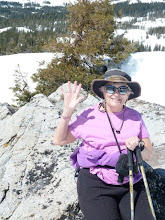

Isabella is the home of several subspecies of giant Tortoises. It is also home to one of the settled communities in the Galapagos. The pet dogs & cats are threatening the continued existence of the giant tortoises because they attack baby tortoises. For these reasons, there is an ecological preserve that functions as a 'hatchery' for the giant tortoises.
Our guide was a very enthusiastic Galapagos native who took great pride in Ecuador's efforts to protect the giant tortoises. In the photo he is holding a tortoise egg and the assistant is holding a 4 month old baby tortoise. They collect the eggs & put them in incubators, adjusting the temperature to produce more female tortoises than males. Tortoise gender is apparently determined by the incubating heat and warmer temps produce more females than males. The difference is only about 2 degrees. They are producing more females because of the population decline and they need fewer males to impregnate many females. They keep the small babies in wire cages so that predators cannot eat them before they grow up.
This preserve also has injured tortoises. The one pictures was burned in a fire on Isabella a number of years ago. The scars on the carapace are permanent.




















 We spent an afternoon in the Beach resort town of Salinas, several hours south of Guayaquil. June is a winter month in Ecuador and the weather at the beach was overcast and not very warm. We had lunch first, before hitting the beach, at a Cerviche place, which was rather overwhelmed by the size our our group. While waiting for cerveza, we took pictures of each other. On the right is a picture of my lane mate Rick, me, my roommate Ulrike and swim pal Tony. This was taken by Tony’s wife Cathi. My hair was still wet from rinsing all the aloe vera out of it. The beer was good and our table of 5 finished off something like 7 quarts before the ceviche arrived, but then Ulrike is German and she does like her beer!
We spent an afternoon in the Beach resort town of Salinas, several hours south of Guayaquil. June is a winter month in Ecuador and the weather at the beach was overcast and not very warm. We had lunch first, before hitting the beach, at a Cerviche place, which was rather overwhelmed by the size our our group. While waiting for cerveza, we took pictures of each other. On the right is a picture of my lane mate Rick, me, my roommate Ulrike and swim pal Tony. This was taken by Tony’s wife Cathi. My hair was still wet from rinsing all the aloe vera out of it. The beer was good and our table of 5 finished off something like 7 quarts before the ceviche arrived, but then Ulrike is German and she does like her beer!




 The Historical Park was one of the nicest places in Guayaquil. It had several natural ecological areas (e.g., mangrove riperian habitat) as well historical buildings, a botanical park (see picture to left) and various indigenous animals, including the green parrots pictured below.
The Historical Park was one of the nicest places in Guayaquil. It had several natural ecological areas (e.g., mangrove riperian habitat) as well historical buildings, a botanical park (see picture to left) and various indigenous animals, including the green parrots pictured below.






